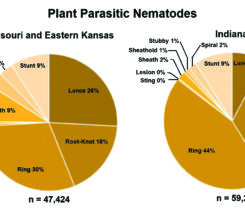University of Illinois shares preliminary research on nematodes and Holganix
 University of Illinois at Urbana-Champaign recently released preliminary results from its research on nematodes and Holganix. The nematodes currently being studied include pathogenic root-knot and soybean cyst nematodes, according to a press release.
University of Illinois at Urbana-Champaign recently released preliminary results from its research on nematodes and Holganix. The nematodes currently being studied include pathogenic root-knot and soybean cyst nematodes, according to a press release.
While studies are still ongoing, preliminary results have shown a 75 percent reduction in pathogenic nematodes with Holganix technology in a lab setting and a 50 percent reduction in pathogenic nematodes in a field setting, according to Holganix. When specific to tomatoes and the root-knot nematode, Kris Lambert, Ph.D., associate professor at the University of Illinois’ school of Crop Sciences, reports that he has seen zero root-knot nematodes in Holganix technology treated tomato plants.
The company says it decided to invest in research to better understand the benefits of Holganix technology on pathogenic nematodes after some Florida superintendents reported positive results while using Holganix Golf. Shannon Easter, the director of golf maintenance and environmental consultant for Broken Sound Golf Club in Boca Raton, Fla, saw an average 60 percent decrease in pathogenic nematode counts and attributes the results to Holganix Golf, according to the company.
Holganix technology is “complex,” explains Lambert, the researcher conducting trials of Holganix technology. “There’s a lot of things going on in the jug and it is difficult to state with certainty why Holganix technology is producing results,” says Lambert, but he does have three theories.
- Affecting migration to the roots — Holganix technology appears to confuse or incapacitates the nematode so it can’t migrate to the plant and cause harm.
- Inhibiting eggs from hatching — Holganix technology may be inhibiting soybean cyst nematode eggs from hatching.
- Targeting pathogenic nematodes — Microbes in Holganix technology may be attacking pathogenic nematodes.
Lambert will need to replicate both the lab and field trials before drawing conclusive results regarding the effect, mechanism and application of Holganix technology, when used as a treatment against pathogenic nematodes.
At the end of the day, “chemical treatments (nematicides) are extremely expensive for growers and turf professionals,” explains Lambert. “The fact that Holganix technology is better for the environment, technician and pocket-book, is exciting. We are crossing our fingers and hoping for additional positive feedback.”
Today, Holganix does not offer a registered nematicide product and results on Holganix technology’s influence over pathogenic nematodes are still pending.











